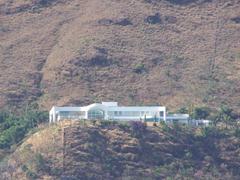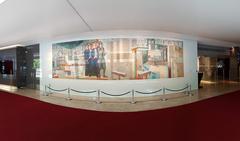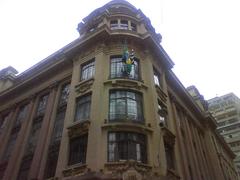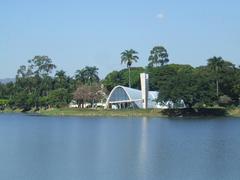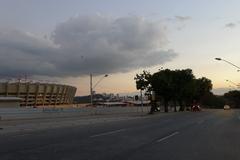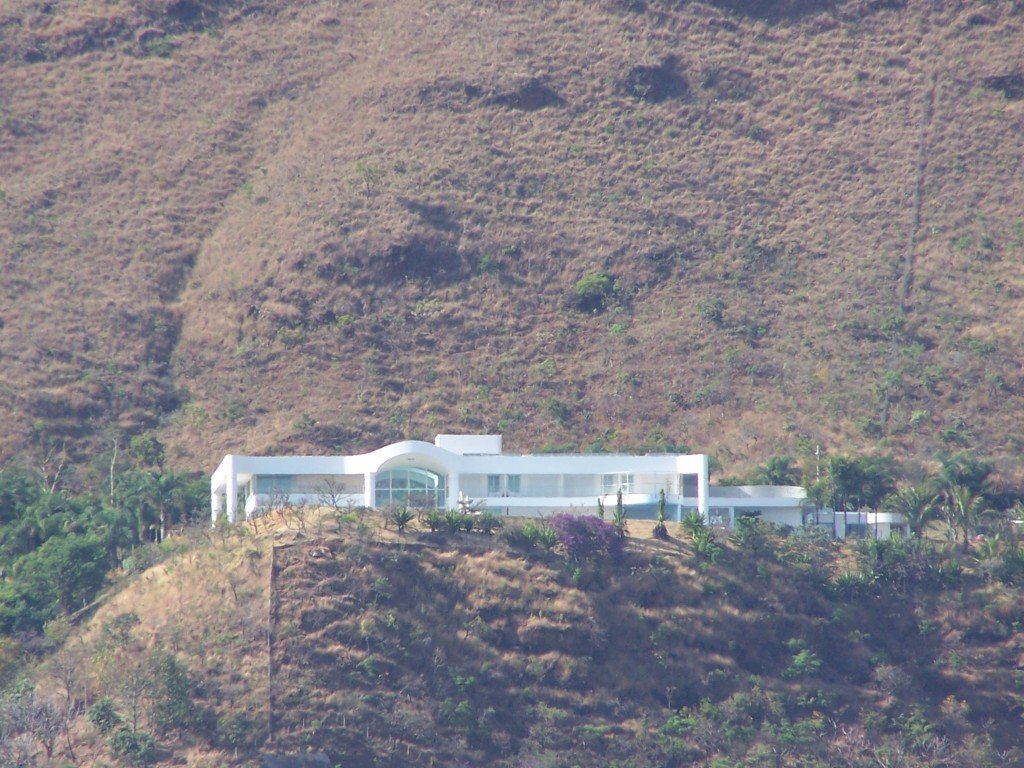
Visiting Palácio das Mangabeiras in Belo Horizonte: Hours, Tickets, and Tips
Date: 19/07/2024
Introduction: Discover the Charm and History of Palácio das Mangabeiras in Belo Horizonte
Nestled in the vibrant city of Belo Horizonte, Brazil, Palácio das Mangabeiras stands as a monumental beacon of the country’s rich architectural and cultural heritage. Designed by the legendary modernist architect Oscar Niemeyer and constructed between 1959 and 1963, this palace initially served as the official residence for the Governor of Minas Gerais. Over the decades, it has evolved into a cultural hub, welcoming visitors from around the globe to explore its historical and architectural significance (ArchDaily). The palace’s design, characterized by clean lines, open spaces, and a harmonious integration with the surrounding landscape, is a testament to Niemeyer’s architectural philosophy. Today, Palácio das Mangabeiras is not just an architectural marvel but also a vibrant cultural venue hosting art exhibitions, musical performances, and educational workshops, thereby enriching the local community and preserving its historical legacy (Niemeyer Foundation, Belo Horizonte Cultural Foundation). This guide aims to provide potential visitors with detailed information on the palace’s history, architectural features, visiting hours, ticket prices, accessibility options, and travel tips, ensuring an enriching and memorable experience for all.
Table of Contents
- [History of Palácio das Mangabeiras](#history-of-palácio-das-mangabeirashistory-of-palácio-das-mangabeiras)
- [Early Beginnings and Construction](#early-beginnings-and-constructionearly-beginnings-and-construction)
- [Architectural Significance](#architectural-significancearchitectural-significance)
- [Political and Cultural Role](#political-and-cultural-rolepolitical-and-cultural-role)
- [Transition to a Cultural Venue](#transition-to-a-cultural-venuetransition-to-a-cultural-venue)
- [Preservation and Restoration Efforts](#preservation-and-restoration-effortspreservation-and-restoration-efforts)
- [Historical Events and Notable Visitors](#historical-events-and-notable-visitorshistorical-events-and-notable-visitors)
- [Impact on Local Community](#impact-on-local-communityimpact-on-local-community)
- [Educational and Research Opportunities](#educational-and-research-opportunitieseducational-and-research-opportunities)
- [Visiting Information](#visiting-informationvisiting-information)
- [Visiting Hours](#visiting-hoursvisiting-hours)
- [Ticket Prices](#ticket-pricesticket-prices)
- [Accessibility](#accessibilityaccessibility)
- [Travel Tips](#travel-tipstravel-tips)
- [FAQs](#faqsfaqs)
- [Conclusion: Key Takeaways](#conclusion-key-takeawaysconclusion-key-takeaways-for-visiting-palácio-das-mangabeiras)
- [References](#referencesreferences)
History of Palácio das Mangabeiras
Early Beginnings and Construction
Palácio das Mangabeiras, located in Belo Horizonte, Brazil, is a significant historical and cultural landmark. The palace was commissioned in the late 1950s by Juscelino Kubitschek, the then-Governor of Minas Gerais, who later became the President of Brazil. The construction of the palace began in 1959 and was completed in 1963. The architectural design was entrusted to Oscar Niemeyer, a renowned Brazilian architect known for his modernist style and significant contributions to the design of Brasília, the capital of Brazil (ArchDaily).
Architectural Significance
Oscar Niemeyer’s design for Palácio das Mangabeiras is a testament to his modernist architectural philosophy. The palace features clean lines, open spaces, and an integration with the surrounding landscape, which is characteristic of Niemeyer’s work. The building is constructed primarily from concrete and glass, materials that Niemeyer favored for their versatility and modern appeal. The palace’s design also includes elements that reflect the Brazilian identity, such as the use of local materials and the incorporation of traditional motifs (Niemeyer Foundation).
Political and Cultural Role
Palácio das Mangabeiras has played a significant role in the political and cultural history of Minas Gerais and Brazil. Initially, it served as the official residence of the Governor of Minas Gerais. Over the years, it has hosted numerous political events, state functions, and cultural activities. The palace has been a venue for important meetings and discussions that have shaped the political landscape of the region. Its role as a political hub has made it a symbol of governance and authority in Minas Gerais (Minas Gerais Government).
Transition to a Cultural Venue
In recent years, Palácio das Mangabeiras has transitioned from being a political residence to a cultural venue. In 2019, the government of Minas Gerais decided to open the palace to the public, transforming it into a space for cultural events, exhibitions, and public visits. This transition has allowed the palace to become more accessible to the general public, providing an opportunity for visitors to explore its architectural beauty and historical significance. The palace now hosts a variety of cultural programs, including art exhibitions, musical performances, and educational workshops (Belo Horizonte Cultural Foundation).
Preservation and Restoration Efforts
Preserving the historical and architectural integrity of Palácio das Mangabeiras has been a priority for the government and cultural organizations. Over the years, several restoration projects have been undertaken to maintain the palace’s structure and aesthetics. These efforts have included the restoration of the building’s façade, the refurbishment of its interiors, and the conservation of its surrounding gardens. The goal of these preservation efforts is to ensure that the palace remains a valuable cultural and historical asset for future generations (National Institute of Historic and Artistic Heritage).
Historical Events and Notable Visitors
Throughout its history, Palácio das Mangabeiras has been the site of numerous historical events and has hosted many notable visitors. The palace has welcomed heads of state, diplomats, and cultural figures from around the world. One of the most significant events in the palace’s history was the visit of Queen Elizabeth II in 1968, during her state visit to Brazil. This visit highlighted the palace’s importance as a symbol of Minas Gerais’ political and cultural heritage. Other notable visitors have included international artists, writers, and scholars who have contributed to the palace’s rich cultural legacy (BBC News).
Impact on Local Community
The opening of Palácio das Mangabeiras to the public has had a positive impact on the local community. It has become a popular destination for both residents and tourists, contributing to the cultural and economic vitality of Belo Horizonte. The palace’s cultural programs and events have provided opportunities for local artists and performers to showcase their talents, fostering a vibrant cultural scene in the city. Additionally, the palace’s gardens and public spaces have become a favorite spot for leisure and recreation, enhancing the quality of life for the local community (Belo Horizonte Tourism Board).
Educational and Research Opportunities
Palácio das Mangabeiras also serves as an important educational and research resource. The palace’s archives and collections provide valuable materials for historians, architects, and researchers studying the history and culture of Minas Gerais and Brazil. Educational programs and guided tours offered at the palace help to educate visitors about its historical and architectural significance. These initiatives aim to promote a deeper understanding and appreciation of the palace’s role in Brazilian history and culture (Federal University of Minas Gerais).
Visiting Information
Visiting Hours
Palácio das Mangabeiras is open to visitors from Tuesday to Sunday, from 9:00 AM to 5:00 PM. The palace is closed on Mondays and public holidays. It is recommended to check the official website for any updates or changes to the visiting hours (Belo Horizonte Cultural Foundation).
Ticket Prices
Entrance to Palácio das Mangabeiras is free for all visitors. However, certain special exhibitions and events may require tickets. It is advisable to check the official website for information on upcoming events and ticket prices (Belo Horizonte Cultural Foundation).
Accessibility
Palácio das Mangabeiras is committed to providing accessibility for all visitors. The palace is equipped with ramps and elevators to accommodate visitors with mobility impairments. Additionally, there are accessible restrooms and designated parking spaces for people with disabilities. For further assistance, visitors can contact the palace’s visitor services (Belo Horizonte Cultural Foundation).
Travel Tips
- Best Time to Visit: The best time to visit Palácio das Mangabeiras is during the dry season, from May to September, when the weather is pleasant and ideal for exploring the gardens and outdoor spaces.
- Transportation: The palace is easily accessible by public transportation. Visitors can take buses or taxis from various parts of Belo Horizonte. There is also ample parking available for those traveling by car.
- Guided Tours: To enhance your visit, consider joining a guided tour. These tours provide in-depth information about the palace’s history, architecture, and cultural significance.
- Nearby Attractions: While visiting Palácio das Mangabeiras, consider exploring other nearby attractions such as the Pampulha Modern Ensemble, the Inhotim Museum, and the Mercado Central de Belo Horizonte.
FAQs
What are the visiting hours for Palácio das Mangabeiras?
Palácio das Mangabeiras is open from Tuesday to Sunday, 9:00 AM to 5:00 PM. It is closed on Mondays and public holidays.
How much do tickets cost for Palácio das Mangabeiras?
Entrance to the palace is free, but certain exhibitions and events may require tickets. Check the official website for details.
Is Palácio das Mangabeiras accessible to people with disabilities?
Yes, the palace is equipped with ramps, elevators, accessible restrooms, and designated parking spaces for visitors with disabilities.
Conclusion: Key Takeaways for Visiting Palácio das Mangabeiras
Palácio das Mangabeiras is a landmark that transcends its architectural brilliance to embody the cultural and historical essence of Belo Horizonte and Brazil as a whole. Initially built as a political residence, its transition into a public cultural venue has made it accessible to a broader audience, allowing visitors to appreciate its historical significance and modernist design. The palace offers a plethora of experiences, from guided tours and interactive exhibits to serene garden walks and vibrant cultural events, making it a must-visit destination for anyone interested in architecture, history, and art. With its commitment to accessibility and community engagement, Palácio das Mangabeiras continues to serve as a vital cultural asset, enriching the lives of both locals and tourists. Plan your visit today to immerse yourself in the beauty and heritage of this iconic landmark, and don’t forget to check out the latest updates and events on their official website (BBC News, Minas Gerais Government, Federal University of Minas Gerais).
References
- ArchDaily. (n.d.). Palácio das Mangabeiras. Retrieved from ArchDaily
- Niemeyer Foundation. (n.d.). Retrieved from Niemeyer Foundation
- Belo Horizonte Cultural Foundation. (n.d.). Retrieved from Belo Horizonte Cultural Foundation
- BBC News. (n.d.). Queen Elizabeth II’s visit to Brazil. Retrieved from BBC News
- Minas Gerais Government. (n.d.). Palácio das Mangabeiras. Retrieved from Minas Gerais Government
- Federal University of Minas Gerais. (n.d.). Palácio das Mangabeiras. Retrieved from Federal University of Minas Gerais
